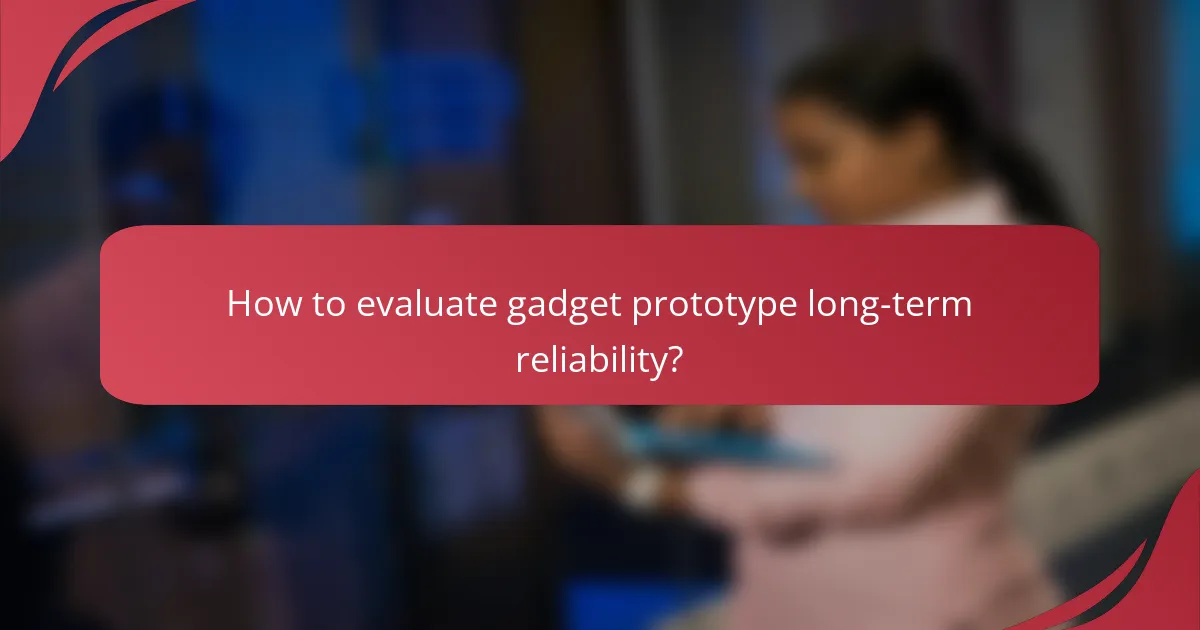Evaluating the long-term reliability of gadget prototypes is crucial for ensuring their performance and durability over time. This process involves various systematic testing methods, including accelerated life testing and environmental stress testing, alongside metrics that help identify potential failures. Adhering to professional standards for reliability testing further ensures that products meet necessary safety and quality benchmarks throughout their development lifecycle.

How to evaluate gadget prototype long-term reliability?
Evaluating the long-term reliability of a gadget prototype involves systematic testing methods to assess performance over time. Key evaluation techniques include accelerated life testing, environmental stress testing, field testing with user feedback, statistical reliability analysis, and failure mode and effects analysis.
Accelerated life testing
Accelerated life testing (ALT) simulates long-term usage conditions in a shorter time frame by applying stress factors such as temperature, humidity, and voltage. This method helps identify potential failure points and lifespan estimates by observing how prototypes behave under extreme conditions.
When conducting ALT, it’s crucial to select stress levels that are realistic yet challenging. For example, exposing a device to temperatures 20-30% above its rated limits can reveal weaknesses without causing immediate failure.
Environmental stress testing
Environmental stress testing evaluates how a gadget prototype performs under various environmental conditions, such as extreme temperatures, humidity, and exposure to dust or moisture. This testing helps ensure that the device can withstand real-world conditions it may encounter during its lifecycle.
Consider using standardized tests like IP ratings for moisture and dust resistance or MIL-STD-810 for military-grade durability. These benchmarks provide a clear framework for assessing environmental resilience.
Field testing with user feedback
Field testing involves deploying the gadget prototype in real-world scenarios to gather user feedback on performance and reliability. This method allows designers to observe how the device functions in everyday use and identify any unforeseen issues.
To maximize the effectiveness of field testing, engage a diverse group of users and encourage them to report any malfunctions or usability concerns. This feedback can guide further refinements and enhance long-term reliability.
Statistical reliability analysis
Statistical reliability analysis uses mathematical models to predict the likelihood of failure over time based on collected data. This analysis helps quantify reliability metrics such as mean time to failure (MTTF) and failure rate.
Utilizing tools like Weibull analysis can provide insights into failure patterns and help in making informed decisions about design improvements. Regularly updating this analysis with new data ensures ongoing reliability assessments remain accurate.
Failure mode and effects analysis
Failure mode and effects analysis (FMEA) systematically identifies potential failure modes of a gadget prototype and assesses their impact on performance. This proactive approach helps prioritize design changes that can mitigate risks before full-scale production.
To conduct an effective FMEA, assemble a cross-functional team to brainstorm potential failures, evaluate their severity, and develop action plans. This collaborative effort can significantly enhance the reliability of the final product.

What metrics are used in reliability evaluation?
Reliability evaluation metrics are essential for assessing the long-term performance of gadget prototypes. These metrics help identify potential failures and ensure that products meet quality standards over time.
Mean time to failure (MTTF)
Mean time to failure (MTTF) measures the average time a device operates before it fails. This metric is crucial for understanding the lifespan of a gadget and is typically expressed in hours or days. For consumer electronics, MTTF values can range from thousands to tens of thousands of hours, depending on the product type.
To calculate MTTF, divide the total operational time by the number of failures observed. A higher MTTF indicates better reliability, making it a key metric for manufacturers aiming to enhance product durability.
Failure rate
The failure rate quantifies the frequency of failures in a given time period, typically expressed as failures per unit of time. This metric is often used in conjunction with MTTF to provide a clearer picture of reliability. For example, a failure rate of 0.01 failures per hour suggests that, on average, one failure occurs every 100 hours of operation.
Understanding the failure rate helps manufacturers identify potential issues early in the design process. A low failure rate is desirable, as it indicates that the product is likely to perform reliably over its intended lifespan.
Reliability function
The reliability function describes the probability that a product will perform its intended function without failure over a specified time period. This function is often represented mathematically and can be used to predict future performance based on historical data. A common approach is to use the exponential distribution for products with a constant failure rate.
Evaluating the reliability function allows engineers to make informed decisions about design improvements and maintenance schedules. It is essential for ensuring that products meet customer expectations and regulatory standards.
Availability metrics
Availability metrics assess the proportion of time a system is operational and accessible for use. This is particularly important for gadgets that require high uptime, such as medical devices or industrial equipment. Availability is typically expressed as a percentage, with higher values indicating better performance.
To calculate availability, use the formula: Availability = (Total Uptime) / (Total Uptime + Total Downtime). Aiming for availability rates above 95% is common in many industries, ensuring that products are reliable and ready for use when needed.

What professional standards guide reliability testing?
Professional standards for reliability testing provide frameworks to ensure that products meet safety, quality, and performance requirements. These standards help organizations systematically evaluate and enhance the reliability of their gadgets throughout the development process.
IEC 61508 for functional safety
IEC 61508 is an international standard that focuses on the functional safety of electrical, electronic, and programmable electronic safety-related systems. It outlines a lifecycle approach to safety, emphasizing risk assessment and management throughout the product’s development and operational phases.
When applying IEC 61508, companies must identify potential hazards, assess risks, and implement safety measures to mitigate them. This standard is particularly relevant for industries such as automotive, aerospace, and manufacturing, where safety is critical.
ISO 9001 for quality management
ISO 9001 is a widely recognized standard for quality management systems (QMS) that ensures organizations consistently meet customer and regulatory requirements. It emphasizes a process-based approach, focusing on continuous improvement and customer satisfaction.
Implementing ISO 9001 involves establishing a QMS that includes documentation, process control, and regular audits. Organizations often see improved efficiency and reduced waste, which can enhance the reliability of their products over time.
ASTM standards for product testing
ASTM International develops and publishes voluntary consensus technical standards for a wide range of materials, products, systems, and services. These standards provide guidelines for testing methods and performance criteria, ensuring that products meet specific reliability benchmarks.
For example, ASTM D638 outlines the testing of plastics, while ASTM F963 covers toy safety. Adhering to these standards helps manufacturers demonstrate compliance and build trust with consumers, ultimately leading to more reliable products.

How does environmental impact affect reliability?
Environmental factors significantly influence the long-term reliability of gadget prototypes. Temperature, humidity, and mechanical stress from vibrations can lead to failures or performance degradation over time.
Temperature variations
Temperature extremes can cause materials to expand or contract, leading to mechanical stress and potential failure. For example, electronic components may operate reliably within a range of -20°C to 60°C, but exceeding these limits can result in malfunction.
When designing prototypes, consider thermal cycling tests to simulate real-world conditions. This helps identify weaknesses in materials and connections that may not be evident under stable conditions.
Humidity effects
High humidity can lead to corrosion and short-circuiting in electronic devices. Prototypes exposed to moisture should be tested for their ability to withstand humidity levels of 85% or higher for extended periods.
Implementing protective coatings or using moisture-resistant materials can enhance reliability. Regular testing in controlled humidity environments can help ensure that prototypes maintain functionality in various climates.
Vibration and shock resistance
Gadgets often experience vibrations and shocks during use, which can damage internal components. Testing for vibration resistance typically involves subjecting prototypes to frequencies ranging from 5 Hz to 500 Hz to assess their durability.
To improve shock resistance, consider using shock-absorbing materials or enclosures. It’s also beneficial to perform drop tests from various heights to evaluate how well the prototype withstands impacts.

What are the common challenges in reliability testing?
Reliability testing faces several challenges that can impact the accuracy and effectiveness of evaluations. Key issues include resource allocation, time constraints, and difficulties in interpreting data, each of which can hinder the reliability assessment of gadget prototypes.
Resource allocation
Effective reliability testing requires adequate resources, including skilled personnel, testing equipment, and financial support. Insufficient allocation can lead to rushed tests or incomplete evaluations, compromising the reliability of the results.
To mitigate this challenge, prioritize resource distribution by identifying critical testing phases and ensuring that necessary tools and expertise are available. Regularly review and adjust budgets to align with testing needs, which may fluctuate as the project progresses.
Time constraints
Time constraints are a significant hurdle in reliability testing, often resulting from project deadlines or market pressures. Limited time can force teams to skip essential tests or reduce the duration of testing cycles, leading to unreliable outcomes.
To address time limitations, implement a phased testing approach. Focus on critical tests first and use parallel testing methods where possible. Establish clear timelines for each phase, allowing for flexibility to adapt as issues arise.
Data interpretation difficulties
Interpreting data from reliability tests can be complex, especially when results are ambiguous or contradictory. Misinterpretation can lead to incorrect conclusions about a gadget’s durability or performance, affecting product development decisions.
To improve data interpretation, utilize standardized metrics and benchmarks that facilitate comparison across tests. Engage cross-functional teams to analyze results collaboratively, ensuring diverse perspectives contribute to understanding the data. Regular training on data analysis techniques can also enhance team capabilities in this area.

What are the best practices for ensuring reliability?
Ensuring reliability in gadget prototypes involves systematic testing, adherence to standards, and continuous monitoring throughout the development process. Key practices include using established evaluation methods, defining clear metrics, and following professional guidelines to identify potential failures early.
Evaluation Methods
Effective evaluation methods for gadget prototypes include accelerated life testing, environmental testing, and usability testing. Accelerated life testing simulates long-term usage in a shorter time frame, helping to identify weaknesses. Environmental testing assesses performance under various conditions, such as temperature and humidity, while usability testing focuses on user interaction and satisfaction.
Metrics
Key metrics for assessing reliability include Mean Time Between Failures (MTBF), failure rate, and customer return rates. MTBF provides insight into the average operational time before a failure occurs, while a low failure rate indicates a robust design. Monitoring customer return rates can highlight issues that may not be evident in controlled testing environments.
Professional Standards
Adhering to professional standards, such as ISO 9001 for quality management and IEC 61508 for functional safety, is crucial for ensuring reliability. These standards provide frameworks for systematic processes and risk management, which help in identifying and mitigating potential reliability issues. Compliance with such standards can also enhance market acceptance and consumer trust.


